Cream of the Crop:
One Woman’s Remarkable Journey in the Free Soviet Jewry Movement.
Part I: The Education of Shirley Goldstein
By Leo Adam Biga
EDITOR’S NOTE: In this extended, two-part Jewish Press exclusive, freelance journalist Leo Adam Biga tells the remarkable journey of Omahan Shirley Goldstein in the Free Soviet Jewry movement and how this historic campaign changed her life and is remembered today. In Part One: The Education of Shirley Goldstein, learn about how this “typical” housewife became politicized and educated in the movement is explored. Next week in, Part II: Activist, Humanitarian, Philanthropist, discover the lengths Goldstein went to in her human rights activist work and the generosity displayed, then and now, by her and her husband, Leonard “Buddy” Goldstein.
Housewives and Students and...
They were housewives and students and teachers...They called America and many other Western nations home. Galvanized by the plight of Soviet Jews, this army of everyday citizens, together with activists inside the former Soviet Union, formed a grassroots human rights movement that began modestly enough but grew in force. Activists within the movement wanted nothing less than to make the Union of Soviet Socialist Republics stop its systematic persecution of oppressed minorities.
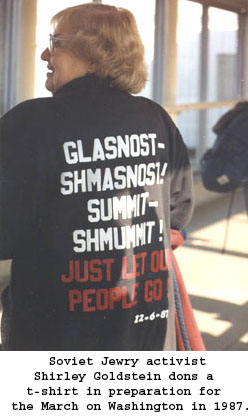
What made the task so daunting is that the target of this action was an authoritarian super power engaged in an ideological Cold War with the West. Nothing suggested this intractable juggernaut would ever bend.
But bend it did.
Some say the freedom movement even contributed to the Soviet state’s eventual collapse. It’s one of the great triumphs over tyranny in human history.
And Omaha’s own Shirley Goldstein played a part in this epoch.
But she could only do it after she transformed herself from causal observer to in-the-trenches activist. In a remarkable journey, she went from zero political involvement to fervent militant. Once caught up in the movement, she devoted much of her time to it, as she has to other causes since then. The experience changed her life.
“It opened up a whole new world,” Goldstein said.
Her diverse work on behalf of Soviet Jews found her, variously: meeting refuseniks and dissidents in Russian apartments or hotel suites; lobbying U.S. government leaders back home to voice criticism of Soviet human rights violations; discussing conditions and strategies with world statesmen and fellow activists at conferences in Washington, D.C., and overseas; and picketing on the streets, almost anywhere, the latest Soviet transgressions.
She saw and did so many things in the course of her involvement that her story provides a useful insider’s look at how the movement evolved and operated.
Like many who got involved in the fight, she found in it a higher purpose. As she put it recently, “What does one do with their life?” Serving others became a calling. “And I’ve loved every minute of it,” she added.
Her politicalization and activism mirrored that of others who came to the cause. “Shirley was typical of the middle class women who normally would not take any part in politics as such. They were really concerned to do something to help the Soviet Jews. They felt it very deeply. I have a great deal of admiration for Shirley Goldstein. She was a leading light for giving morale and financial assistance to refuseniks and for helping them get out, and she did a great deal for those who managed to get out to resettle in Nebraska,” said Michael Sherbourne, a London-based activist who fed Goldstein information from contacts in the Soviet Union.
No Place to Be a Jew
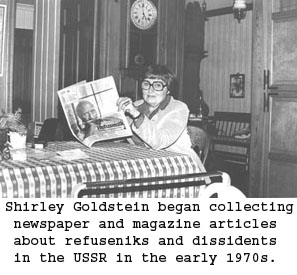
Life behind the Iron Curtain was harsh for the mainstream populace, but even more intolerable for racial, ethnic and religious minorities. Long the target of anti-Semitic pogroms and policies, Soviet Jews were routinely denied such basic rights as the practice of their faith, employment in certain jobs, free travel within the country and emigration outside the USSR. An internal passport all Soviets carried was used to target Jews, whose documents, and whose documents alone, denoted their religion. Jews and sympathizers protesting such discriminatory practices could be arrested, interrogated, harassed or imprisoned.
By the mid-1960s the pleas of a few Jewish dissidents were heard--enough to coalesce the Free Soviet Jewry Movement. But much of the world remained unaware of or apathetic to just how bad things were and just how many Jews wanted out. Compared to the trickle allowed to leave each year, millions more wished to go but were refused. Once a visa was denied, the applicant was branded and blacklisted. Refuseniks automatically lost their jobs and what few privileges they enjoyed. Even more than before, they became outcasts in their own society.
From the mid-’60s through the early ‘90s, the movement--both within the Soviet Union and outside it--forged ahead despite political setbacks. Free Soviet Jewry committees organized.
Under Goldstein’s leadership, Omaha had a particularly active one. Agitators like her from the West, both Jews and non-Jews, made pilgrimages to the Soviet Union to meet with refuseniks and dissidents and activists. She and other Western visitors smuggled in banned materials, such as Judaica, along with items like Levi jeans and Marlboro cigarettes, which brought much on the black market. They also made audio recordings of individuals, whose messages--testifying to the tough conditions and rallying support for freedom--were snuck out and then disseminated to Western media outlets.
Defying initial opposition from the Jewish establishment and the Israeli government and flying in the face of official U.S.-Soviet diplomatic channels, the campaign eventually gained widespread support. The pressure applied by the campaign and by detente succeeded in doing exactly what it set out to. Faced with sanctions and growing world condemnations, the stubborn Soviets finally ended reprisals and eased restrictions.
The sweeping changes ushered in by Mikhail Gorbachev under Glasnost and the eventual dissolution of the Soviet state, opened the borders for a flood of people to legally emigrate. In the end, 1.5 million Jews left, most for the U.S. and Israel. Some 300 families resettled in Omaha.
Becoming an Activist
Shirley Goldstein (formerly Gershun) seemed an unlikely candidate to make history. The Council Bluffs, Iowa, native did part of her growing up in Schuyler, NE, where her family moved, before returning to the Bluffs to complete her schooling. Upon graduation from Abraham Lincoln High School she did what any good Jewish girl did then--she worked (at the Martin bomber plant), got married, and stayed home to raise their three children.
Her husband, Leonard “Buddy” Goldstein, had his own car and truck rental business. An “ordinary” housewife, mother and grandmother, she only became politicized in middle-age. It was the early ’70s when the Free Soviet Jewry movement overtook her, and she morphed into an impassioned advocate. There was a precedent in her past. Her merchant father, Ben Gershun, led the Council Bluffs resettlement of Jewish refugees from post-World War II Europe. She recalls refugees at his general store and at her parents’ home. Much like she’s embraced diversity in her own home, her family’s home was “always open to everybody.” She feels she may also have been prepared for her activist role by the many years she and Buddy hosted international students and dignitaries, many from Asia, in their home. The couple even sponsored a Cambodian refugee family. She said, “I’ve always been interested in other peoples and cultures.”
Not content with merely educating herself on the subject, she went to the USSR seven times, meeting with leaders and rank and file Jews alike. She took chances, brazenly ignoring U.S. State Department warnings and Soviet orders to steer clear of “troublemakers.”
Indeed, she became a familiar figure to refuseniks in Moscow, Leningrad, Kiev, Odessa and other cities. A benevolent angel from the West bearing contraband gifts. A tiny rebel with the brass of a cat burglar. She recorded testimonies and snapped pictures, concealing cassette tapes and film cartridges under her clothes. She sneaked things in and out with a kind of mischievous glee. A true believer unafraid to upset the Politburo or defy KGB agents, who knew of her and tried discouraging her, she carried on anyway. She was on a mission.
“The world had to know what was happening. It was a priority. I would have rather done this than anything else,” she said.
As her involvement deepened, she made more contacts and increased the scope of her activities. She organized Omaha’s Free Soviet Jewry Committee and served on the board of the national Union of Councils for Soviet Jews. She led demonstrations (including ones outside the Orpheum Theatre and Joslyn Art Museum, using the appearances of Russian performing artists as the pretext or stage to protest Soviet policies), she walked in marches and she participated in vigils. She called on members of Congress. She attended meetings in Washington, D.C. and in Madrid, Spain (for the Helsinki Accords). She raised awareness and funds.
When not educating elected leaders herself, she recruited new blood, such as the late Ally Milder, to do so. In her role as an aide to U.S. Sen. Charles Grassley (D-Iowa), Milder brought him on board with the movement. Goldstein also spearheaded letter writing campaigns that sent morale-boosting notes to refuseniks and that made appeals for support to public officials. She organized relief drives that collected goods and shipped them to families in the USSR.
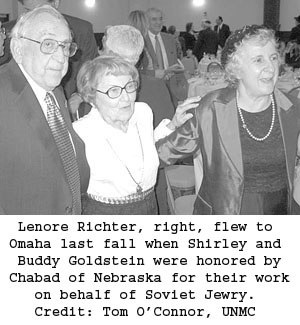
“In the big picture of the Soviet Jewry movement, Shirley was a really great foot soldier and the leaders knew that,” said former Omahan Stephanie (Seldin) Howard, co-producer of Let My People Go, a new documentary on the movement. “Shirley’s is a great story because she rallied a whole Jewish community and they did great things, and they’re recognized for it. You talk to people in New York or San Francisco or Chicago who were in the movement and everybody knows Shirley.”
Goldstein never strayed from the fight. When Soviet Jews began coming, she picked up the mantle again and immersed herself in all facets of the resettlement program. Through it all, Buddy Goldstein, was by her side, just as he remains today. He didn’t always accompany her on her far-flung travels, but he supported her and underwrote her activism, sharing her concerns and encouraging her efforts, even when some friends questioned if she was going too far. In a recent interview at their home, the couple recounted her remarkable journey from uniformed innocent to well-traveled activist.
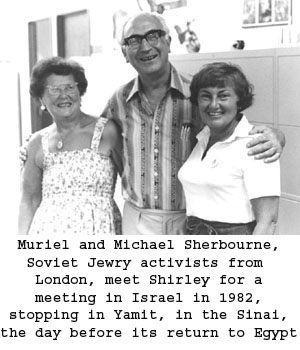
It all started when the two returned from a 1972 trip to the USSR frustrated by the limited access they’d had to the Jewish proletariat and their daily lives. “I’d been doing a lot of reading. I was interested. But I wasn’t able to see anybody--I didn’t know how to do it. Being tourists, it was all surface. It was definitely controlled. We only saw what the government wanted us to see,” she said.
She itched for a way to bypass approved itineraries in order to connect, on a human level, with Jews and learn first-hand their struggles.
“I wanted to see the real Russia and visit with some refusenik families.”
Enter Glenn Richter. A veteran of the civil rights movement and a founder of the Student Struggle for Soviet Jews, Richter is a relative of Goldstein’s. He’s married to her cousin Lenore. The couple live in New York.
“Glenn and Lenore had been to Omaha (on a cross-country speaking tour) not too much before we took our trip talking about a lot of the things that were going on in the Soviet Union,” she recalled. “After we got back, I called Glenn and said, ‘I want to know more about what’s happening.’ But first I registered for a couple courses on Russia at the university (then Omaha University - now part of the state system: University of Nebraska-Omaha).”
The courses culminated in a 1973 trip to the USSR led by chancellor Ron Roskens. “I decided I wanted to go. I called Glenn and said, ‘I want to know how to meet these people, by which I meant refuseniks. We spoke every Sunday morning for weeks. Then he outlined it all for me on a sheet of yellow paper (now in the archives of “Remember and Save”, an Israeli-based initiative documenting the Jewish Aliya Movement of the USSR).
“Glenn told me what to do, what items to take, who to visit, what things to tell them and what information to bring back. He gave very good directions. Without Glenn’s help I never would have gotten into this as I did,” she said. “I did exactly as he told me and it was very successful. I met many people. Each time I went it made me hungry to learn more. And that was the beginning of it.”
Richter recalled Goldstein being an avid student.
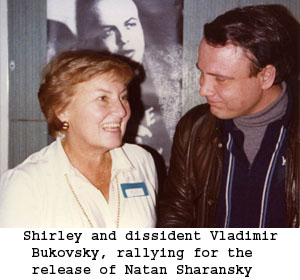
“We were dealing at that time with what was largely a hardly-understood situation, with few appeals coming out from the USSR, relying basically on facts known to us at that point, rather than the personal contacts which we all developed. Shirley was quite interested. She's a good listener--and a good questioner,” he said.
He added she and Buddy were well-positioned to serve the cause. “One of the great strengths of Jews in smaller Jewish communities, such as Omaha or Denver, is the long-term friendships they may have with people who get into political power.
Shirley and Buddy were excellent examples. Their Congressmen and Senators became their advocates. Shirley knew which political buttons to press, and did so on behalf of individual refuseniks and prisoners and of the Jackson-Vanik Amendment--the landmark legislation linking Jewish emigration with trade credits for the USSR.”
He admired her dedication.
“Dogged, committed, focused, interested would be understatements when it came to Shirley’s advocacy for Soviet Jews,” he said. “I see the same traits in my wife Lenore. Perhaps it’s family genes.”
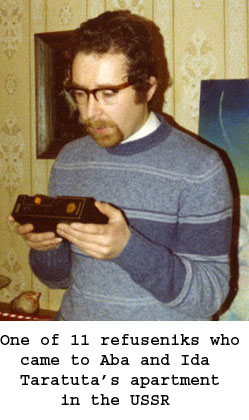
Goldstein’s involvement in the movement came just as it was picking up steam. Or, as she likes to put it, “When I came into it, everything was already going on.
“I don’t think anyone of us in the early 1970s knew where the Soviet Jewry movement would take us,” Richter said. “By ’73-74 we were in the big leagues, utilizing Congress to take on the Kremlin head-to-head over the Jackson-Vanik Amendment. Shirley was in the thick of things, using all the political connections she developed” (with Sen. Jim Exon, Rep. John Cavanaugh, and others).
It was crucial for Congress to see pressure not only from the traditionally large areas of Jewish population, but from a wide swath of communities with smaller Jewish populations, as in Nebraska, Minnesota, Iowa, Colorado.
“Politicians will stick their necks out only if they believe their constituents are with them, and Shirley and her colleagues made sure of that,” Richter added.
Richter said the famous Soviet dissident, Anatoly (now Natan) Sharansky, “often tells the story that his KGB interrogators tried to torment him by telling him he was only supported by Western ‘students and housewives.’ But that was the strength of the Soviet Jewry movement. We utterly believed in what we were doing. We didn’t let considerations that would sidetrack a ‘professional’ get in the way.”
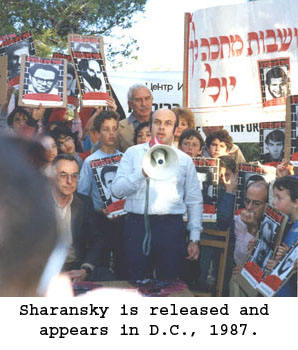
From what he saw, Shirley was absolutely typical of the Jewish housewife who devoted the same focus and energy to Soviet Jews thousands of miles away as she did to her own family.
Because, he said, “indeed, these Soviet Jews, became our family. I’d sit at meetings of the Union of Councils in Washington, D.C., and marvel at the truly diverse dozens of women and men who, for whatever personal reasons, simply decided that they had to get involved and became heroines and heroes of the movement.”
Most people watch history go by.
“Shirley and her colleagues simply decided, each on her/his own, that they were going to shape history. The core group of activists, like Shirley, seemed to utilize every waking hour to create new ways of advocating on behalf of our friends trapped in the USSR and to keep their spirits up,” he said.
To Russia with Love
By the time she made that ’73 UNO trip to the USSR, accompanied by her daughter Gail Raznick, she was well-read on the Soviet Jewry issue. She’d been briefed by Glenn Richter and other Union of Councils’ members and been given contact names.
But her real education began abroad, meeting Russian Jews whose lives were filled with hardships in the totalitarian and anti-Semitic regime. She met them in their homes or in her hotel suites. She visited their synagogues and schools.
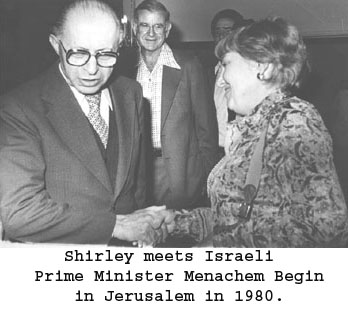 Despite little hope for change, Soviet Jews yearned and struggled for freedom. That’s when it all hit home. That’s when the cause got in her blood. Until then, the problems faced by Soviet Jews were still abstract and far removed.
Despite little hope for change, Soviet Jews yearned and struggled for freedom. That’s when it all hit home. That’s when the cause got in her blood. Until then, the problems faced by Soviet Jews were still abstract and far removed.
“Then you meet people, like I did, who can’t get out and, well...Once I met this young family - Aba and Ida Taratuta - I became totally committed, not only to work for Soviet Jews but people in all the Iron Curtain countries.”
In an interview she gave during the height of the movement, Goldstein explained why she threw herself into the fray: “These people cannot speak out for themselves, so other people must do it for them. I feel like what I am doing is something important. It’s hard for people in the U.S. to grasp what all they have to give up just for wanting to leave and how much support they need just to survive. Seeing all they endure makes you want to help just one more case. You get hooked. It’s like an addiction.”
She and Buddy were also alarmed by how the world kept relatively silent as the repression went unchecked. It was an ugly reminder of what happened during the Holocaust.
“People didn’t speak out then about the oppression,” he said. “Those were atrocities,” she interjected. “Atrocities, yes, but a lot of people felt anything could happen” in the Soviet Union.
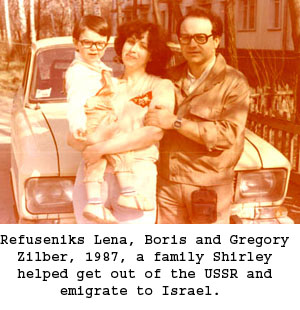 “That’s right,” she added, “because people were disappearing in Russia. They’d just be taken off the street...for no reason. And we thought if they can do that, they can do anything.”
“That’s right,” she added, “because people were disappearing in Russia. They’d just be taken off the street...for no reason. And we thought if they can do that, they can do anything.”
Then there was the outrageous situation of a government holding hostage, in effect, some of its own people, preventing them from practicing their professions and thus depriving the country of their talents - all as punishment for wanting to leave.
“I never understood why,” Shirley said. “The Soviets weren’t using them. It wasn’t as if the refuseniks kept their jobs and were still vital to the economy. They weren’t. They lost their jobs. They were having a hard time. They were wasting their lives sitting around waiting to get out.”
She was also dismayed by the travel strictures and identity tags foisted on Jews.
Refuseniks she met expressed their despair. Sensing she was someone they could trust to get the truth out, they confided in her. The fact-finding and reporting she and others did there helped the movement gain momentum. Through networking and communication, the Free Soviet Jewry issue was kept alive.
Getting information out meant taking risks.
Testing the Limits, Courting Danger
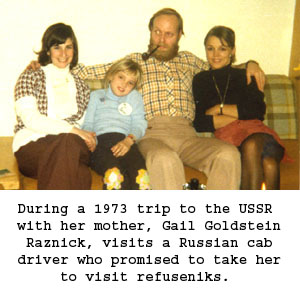
Just how far Goldstein was prepared to go would be tested on that ’73 trip and on later trips. Refuseniks Aba and Ida Taratuta, whom she met in Leningrad, witnessed her resolve. She’d been given their names by Glenn Richter. They were soon impressed by her sincerity and tenacity.
“She was interested in our life, financial situation, the possibility to leave the country and what to do and how to help,” Aba Taratuta said. “She was ready to do everything to help us. And from that visit there was just a constant contact between our families. She wrote a lot of letters describing what she did to help us and other refuseniks. She became very active in the struggle on our behalf.”
Goldstein came bearing gifts
“Shirley brought many items - books, records, tape recorders - that helped us in studying Hebrew or in supporting Zionist activities. The same with cameras, watches and jeans, which we sold. And every time she would bring something personally for us, for our family,” Aba Taratuta said.
Let My People Go producer Stephanie Howard said Ida Taratuta recounted how once Shirley “came with a suitcase full of embroidered towels, fine soaps and things, and Ida told her, ‘I can’t accept this,’ to which Shirley said, ‘But for a twist of fate, I could have been in your place and you could have been in mine. Wouldn’t you do the same for me?’ And Ida replied, ‘How can I argue with that? Of course’”.

But the little Jewish woman from Omaha came with an agenda far beyond trinkets.
“Shirley visited us in Leningrad several times and she was interested in seeing more people, more refuseniks. And for a foreigner in Russia it was not so easy to do,” Aba Taratuta said. “So we tried to gather as many people in our apartment as possible. She was interested in every one and taped the story of everyone and smuggled the tapes out on her person. And it was really dangerous.”
In turn, Goldstein said Aba “was one of the main figures in Leningrad. Gail and I were the first Americans to ever visit him, but he was already well known in the West.” She said he’d “have so many activists come to his apartment...they crowded to get into the rooms. I kept coming back to hear their stories. I made tapes.”
The couple were classic refuseniks-turned-activists. Their situation symbolized the problem, Goldstein said.
“They’d applied to emigrate and were released from their jobs. They were well-educated people. Both spoke good English. He had been a professor. She was a translator. He was reduced to being a caretaker where they lived. She was doing some translating on the side. Their son was taunted at school. I think maybe they were receiving some packages from the West and selling things on the black market. Mail and phone service was compromised. That’s the way it was.”
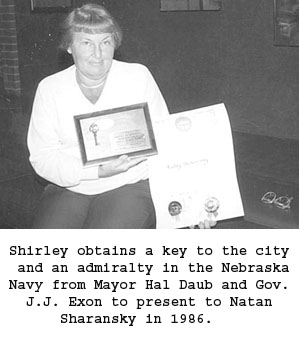
Goldstein’s good friend, Miriam Simon accompanied Shirley and her daughter on the ’73 trip. Simon well recalls what it was like as Shirley went off to attend “clandestine meetings late at night.” “She took a lot of risks. We didn’t know for sure, but we thought everything was bugged. We were very careful what we said to each other,” said Simon.
When Goldstein made later trips to the Soviet Union, Simon added, “We always worried if she would come back. They (Soviet authorities) got to know her and didn’t like her.”
“Shirley often did dangerous things,” Aba Taratuta confirmed. “For example, on her first visit to us, she and her daughter Gail brought some very important books and hid them in Gail’s boots. These visits were very important for us refuseniks. We felt, ‘We are not forgotten...there are people who care and want to help.’ We felt If we were known abroad, it was our best defense from the Soviet government. Then they could not do with us what they wanted.”
Documenting History
When Los Angeles-based documentary filmmaker Laura Bialis was in town a few years ago with her film Tak for Alt: Survival of a Human Spirit, she was approached by some locals about making Omaha resident Shirley Goldstein the subject of her next film. As soon as Bialis learned of Goldstein’s considerable activist role in the Free Soviet Jewry movement, she was sold.
But when asked permission to tell her story, Goldstein made one thing perfectly clear, Bialis recalled. Shirley said, “Well, you can’t make a film about me. It’s not about me at all. It’s about this huge movement, and many people in it were more important than me.”
After being educated about the Free Soviet Jewry movement by Goldstein, Bialis agreed the film needed to tell the larger story of this international campaign. For her co-producer, Bialis teamed with Omaha native Stephanie Howard (formerly Seldin), a Los Angeles television news producer and writer. Their film, Let My People Go, is now in the editing suite and slated for a spring release.
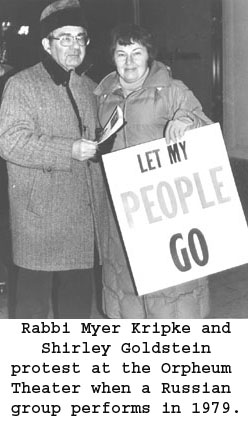
Bialis said the spirit and generosity of Goldstein and her husband Buddy have made the film possible.
“She and Buddy have been so supportive. They provided the seed money to begin production. It was incredibly noble of them. And Shirley’s personal story was the inspiration to make the film. She provided a list of names of people to talk to who were colleagues in the movement. The film kind of grew and grew, because each person we’d interview would give us more names of people to talk to,” Bialis said.
“Shirley warned us it was going to be a lot of work,” Howard said, “but little did we know it had become this huge project. There are veterans of the movement all over this country and in Canada, in Europe and in Israel. So, it became this international effort. Our first interviews were in Omaha and Des Moines. We interviewed Shirley, the late Ally Milder, ADL Director Bob Wolfson, Jews from the FSU, like Lydia Linde, Anna Yuz-Mosenkis)...We’ve got quite a bit of funding from Omaha, a lot because of Shirley. People respect her so much that when they hear she’s going to be in the film they want to honor her and see her story told.”
Howard’s not surprised Goldstein didn’t want the film to focus on her alone. “What I’ve found in interviewing her and others like her from the movement is that these are very humble, unassuming people who truly do not think they did anything extraordinary,” she said.
But Howard and Bialis know different.
“Shirley’s a hero to the Soviet Jews,” Howard said. “and she’s become really involved in other human rights issues. She spearheads stuff. She doesn’t slow down either.”
Even when she had heart surgery a couple years ago, it was a temporary thing. Nothing keeps her down.
“I think what keeps her young is all the things she’s involved in. And she wants to learn more all the time. She and Buddy give to so many projects in the Jewish community. They’re so devoted to each other and to their community. And they’ve instilled that sense of community and philanthropy to others.”
She hasn’t yet met one of the grassroots activists from this movement that is not extraordinary.
“There were many people involved in this movement, but Shirley was one of the leaders and one of the extraordinary people that contributed so much,” Bialis said. She’s well respected by the other leaders in the movement. She was incredible at galvanizing support and getting people excited about it. She still feels so deeply in the movement and in what its values were. And she wants to see it remembered, not for her own personal aggrandizement, but for what it was able to achieve.”
Let My People Go is a production of the Foundation for Documentary Projects. Its been funded in part by a prestigious grant from the National Foundation for Jewish Culture. The filmmakers expect to screen the film in Omaha next spring.
The article was published in the Internet newspaper of the Jewish Federation of Omaha, http://jewishomaha.org/content_display.html?ArticleID=179347
 Despite little hope for change, Soviet Jews yearned and struggled for freedom. That’s when it all hit home. That’s when the cause got in her blood. Until then, the problems faced by Soviet Jews were still abstract and far removed.
Despite little hope for change, Soviet Jews yearned and struggled for freedom. That’s when it all hit home. That’s when the cause got in her blood. Until then, the problems faced by Soviet Jews were still abstract and far removed.  “That’s right,” she added, “because people were disappearing in Russia. They’d just be taken off the street...for no reason. And we thought if they can do that, they can do anything.”
“That’s right,” she added, “because people were disappearing in Russia. They’d just be taken off the street...for no reason. And we thought if they can do that, they can do anything.” 









